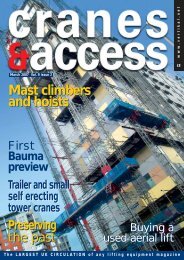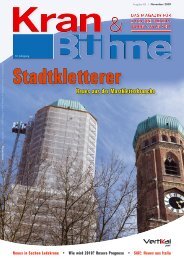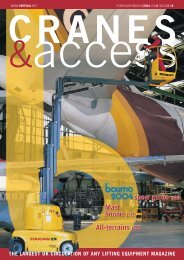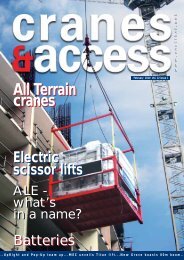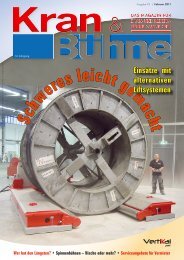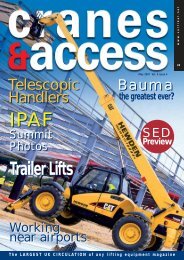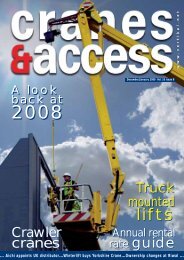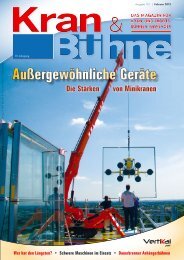Boom lifts All Terrain cranes Batteries Conexpo guide
Boom lifts All Terrain cranes Batteries Conexpo guide
Boom lifts All Terrain cranes Batteries Conexpo guide
Create successful ePaper yourself
Turn your PDF publications into a flip-book with our unique Google optimized e-Paper software.
news c&a<br />
JLG announces<br />
EN15000 solution<br />
JLG has announced that it is equipping its CE marked telehandler range<br />
with a ‘patent pending’ progressive overload device in order to fully<br />
comply with EN15000:2008. The standard requires a longitudinal load<br />
moment system complete with motion cut-outs to prevent both static<br />
and dynamic overloading.<br />
The new system monitors the loading of the rear axle to determine forward<br />
stability. When the system senses the rear axle is getting ‘light’ the operator<br />
is informed via a display in the cab and the lift and telescope-out function<br />
are restricted in speed and if necessary cut altogether, forcing the operator<br />
to retract or lower the boom.<br />
On machines that frequently use buckets - usually with lift heights of 10<br />
metres or less - the overload function is deactivated while the unit is in<br />
travel mode, allowing it to be used dynamically for breaking-out<br />
bulk material. Brian Boeckman, JLG’s global director<br />
product management for telehandlers said:<br />
“Significant effort<br />
has gone into the design<br />
of this system to<br />
ensure minimal<br />
impact on<br />
machine productivity.”<br />
Waste Recyling<br />
crane from Palfinger<br />
Palfinger has launched a new loader crane specifically aimed at the<br />
waste recycling sector. The 22.1 tonne/metre PK 23501-W will be mainly<br />
used for emptying recycling containers such as those used for glass and<br />
paper, particularly when installed below ground level.<br />
The PK 23501-W is mounted behind the cab with the boom stowing on top<br />
of the compactor unit. The boom system features fully enclosed telescopic<br />
cylinders and a clearance height to match the height of the compactor.<br />
The main four section boom<br />
is mounted alongside the<br />
knuckle in order to reduce<br />
overall stowed length, while<br />
optimising the hook height.<br />
In spite of the unusual<br />
configuration, maximum<br />
radius is a healthy 10.2<br />
metres. The crane was<br />
designed for the Dutch<br />
market but is now being<br />
rolled out across Europe.<br />
12 <strong>cranes</strong> & access February 2011<br />
Engineer liable for<br />
crane collapse<br />
Singapore’s High Court has held a structural/mechanical engineer liable<br />
in a civil suit over the collapse of a tower crane that killed three people<br />
at the National University of Singapore in February 2008. Engineer Tan<br />
Juay Pah - who is also an authorised crane inspector - will have to<br />
pay damages to crane supplier Lee Tong Boon, who in turn has to<br />
compensate the main contractor Kimly Construction. The investigation<br />
following the collapse revealed defects in the tower foundation<br />
anchors which should have been picked up prior to erection.<br />
Kimly sued Lee Tong Boon for s$500,000 ($391,000). The victims families<br />
each received s$111,000 ($87,000) in compensation. The accident stopped<br />
work on the site for 25 days while the investigation was carried out. Lee<br />
Tong Boon successfully argued that if he should lose the claim then Tan<br />
should be liable for paying the fine. Justice Tay Yong Kwang, said: “It is<br />
clear in the documents that Mr Tan endorsed the checklist for the<br />
inspection and testing of the tower crane under the relevant regulations,<br />
even if he did not have the opportunity to inspect the mast anchors<br />
before the erection of the crane took place.”<br />
Tan had been hired by the crane’s owner - Lee - to assess its suitability for<br />
the job. In November 2006 he conducted a load test and certified it fit for<br />
use and that its critical parts had been checked and found to be sound. A<br />
year later when the crane was due to be erected at the university, he was<br />
employed again to check and certify it, which he did.<br />
In his defence Tan claimed that the evidence was unreliable and did not<br />
establish a case in law. He also blamed the engineer hired to design and<br />
supervise the building of the crane foundation and the company that<br />
erected and maintained it. Those claims were dismissed with costs.<br />
Tan is considering an appeal while Lee faces criminal charges in<br />
relation to the accident.<br />
First Comansa <strong>cranes</strong> in India<br />
One of the four<br />
Comansa Jie <strong>cranes</strong> at<br />
Marwa power station<br />
Comansa has<br />
delivered its first<br />
four tower <strong>cranes</strong><br />
in India. The<br />
<strong>cranes</strong>, built by<br />
the group’s<br />
Chinese joint<br />
venture Comansa<br />
Jie, were sold to<br />
BGR Energy<br />
Systems which<br />
specialises in the<br />
deisgn and<br />
construction of<br />
power stations. It purchased the four 21CJ290-18 tonne flat top <strong>cranes</strong><br />
specifically for the erection of four massive cooling towers on two<br />
power plant projects.



